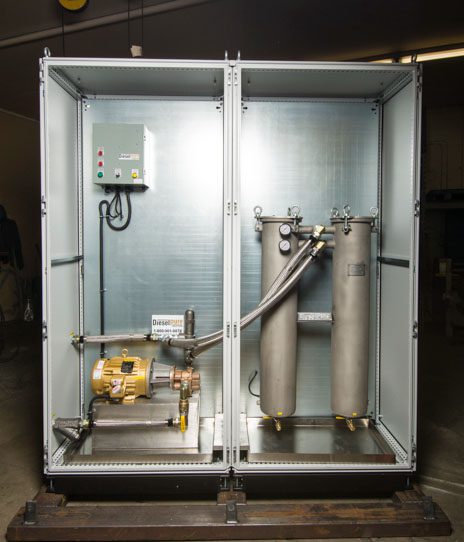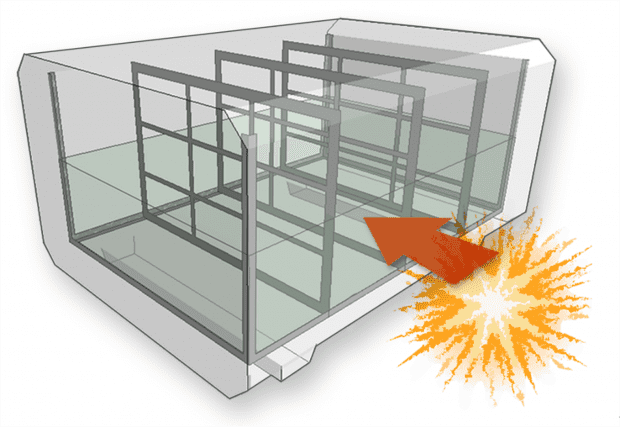At Core Engineered Solutions, we know that a ConVault Aboveground Storage Tank (AST) is an investment in peace of mind. Designed with a steel primary tank, a steel secondary containment layer, and six inches of reinforced concrete, ConVault is built for strength, containment, and code compliance. But even the toughest tanks require intentional maintenance to ensure longevity, warranty coverage, and safety.
Whether your tank supports a fleet fueling operation, backup power for a hospital, or aviation fuel at a municipal airfield, a strong maintenance program prevents costly issues before they arise.
This guide distills the essentials from the official maintenance manual, industry best practices, and our own field experience into one streamlined reference.
1. Visual Inspections: Weekly and Foundational
Weekly walk around inspections are the frontline defense against deterioration. Don’t overthink it — just walk the tank perimeter and look closely.
Key inspection points:
● Concrete Surface & Hairline Cracks: Examine the top surface and beveled edges. Minor hairline cracks are common from thermal expansion but can allow moisture intrusion if neglected. Early sealing prevents deeper structural damage and protects the interstitial space.
● Stains or Leaks: Look for wet spots, fuel smells, or dark streaks. Anything weeping from a crack or pooling underneath warrants attention.
● Labels & Placards: Ensure hazard decals and compartment labels (especially on multi-compartment tanks like diesel/gas split units) are visible and intact.
● Fittings, Nipples & Vents: Confirm that caps are tight, gaskets intact, and paint not chipped. Vent caps should be free from obstructions or debris.
● Foundation Area: Remove weeds, trash, or anything combustible. The tank pad must remain stable and accessible.
Pro tip: Schedule inspections the same day each week. Consistency helps you notice changes faster.
2. Leak Detection: Always Dry, Never Ignore
ConVault’s triple-layered containment offers best-in-class leak defense — but you’re responsible for monitoring it.
● Check the Leak Detector Tube: Open the cap weekly and confirm no fluid has accumulated. Any liquid — even clean water — means something’s wrong.
● Red Flag: Water in the interstice is usually from cracks at the top, not inner-tank failure. But both require action. Don’t just pump it out. Investigate and reseal.
● Electronic Monitoring: If equipped, test alarms regularly. Many fire marshals require documented leak sensor tests annually.
A dry interstice = a healthy tank. Moisture here can trigger alarms, void warranties, and signal real danger.
3. Corrosion Control: Focus on What’s Exposed
The concrete vault does the heavy lifting, shielding the steel tank from corrosion — but some components remain vulnerable.
● Seal and Reseal: Pressure wash and reseal the tank’s top every 2–3 years. In coastal or cold climates, consider 2-year intervals. Use elastomeric or rubberized coatings that flex with concrete movement.
● Hairline Crack Treatment: Clean, dry, and patch cracks early — especially near corners or fittings — to prevent long-term degradation.
● Fittings: Check for rust around nipples, gaskets, or penetrations. Wire-brush, prime, and repaint as needed with rust-inhibiting coatings.
4. Pump, Filter, and Hose Maintenance
Your fuel system is more than a tank. The surrounding equipment needs love too.
● Pump Health: Monitor motor heat, vibration, or noise. Replace filters every 6 months or sooner if flow slows.
● Hoses & Nozzles: Inspect for cracks, swelling, or leaking seals. Damaged hoses risk rupture. Shutoff nozzles must function correctly.
● Spill Buckets: After fuel deliveries, empty rainwater and drips from catch basins. Clean and reseal any cracked basins or gaskets.
Preventative maintenance here is about safety as much as uptime — don’t let a bad hose ruin a compliant system.
5. Vent and Overfill Systems: Safety Under Pressure
NFPA 30 and UL2085 require venting and overfill prevention — you need to keep them functional.
● Normal Vents: Inspect weekly to ensure pipes and screens aren’t clogged with debris or nests.
● Emergency Relief Vent: Lift and reseat annually. It should operate freely and reseal cleanly.
● Overfill Devices: Whether float-based or electronic, test annually and log the results.
Emergency vents must not be painted shut or tampered with. Let them function as intended — it could save lives.
6. Fuel Quality: Clean, Dry, and Additive-Ready
Water and microbes are the hidden killers of diesel fuel tanks.
● Water Monitoring: Use water-detecting paste on sticks or automated sensors monthly. If water is found, remove it with a thief pump.
● Microbial Growth: Water invites bacteria and algae, leading to sludge, filter clogs, and tank corrosion. Treat fuel with biocide additives if needed.
● Turnover & Stability: For tanks that see low usage (like generator backup), use stabilizers and rotate fuel when possible.
If your fuel fails, the tank suffers too. Good fuel = long life.
7. Documentation: Warranty Shield and Inspection Readiness
Documentation is part of the system — not an afterthought.
● Keep logs of all inspections, filter changes, tests, and repairs.
● Document who performed each task, what was found, and what was done.
● Store reports for 3–5 years or more, especially if required by your SPCC plan or local AHJ.
A documented maintenance history protects your warranty and shows regulators you’re in control.
Final Thoughts: Routine = Resilience
ConVault tanks are engineered for minimal upkeep — but not for neglect. A few minutes a week prevents leaks, protects your investment, and keeps you compliant with NFPA 30, UL2085, and local fire codes.
At Core Engineered Solutions, we support owners and facility managers with Sourcewell and GSA-compliant options, fuel system upgrades, and consultation for mission-critical operations.
Your tank was built to last 30 years. With proper care, it will.













